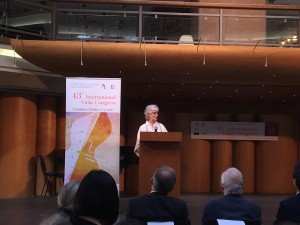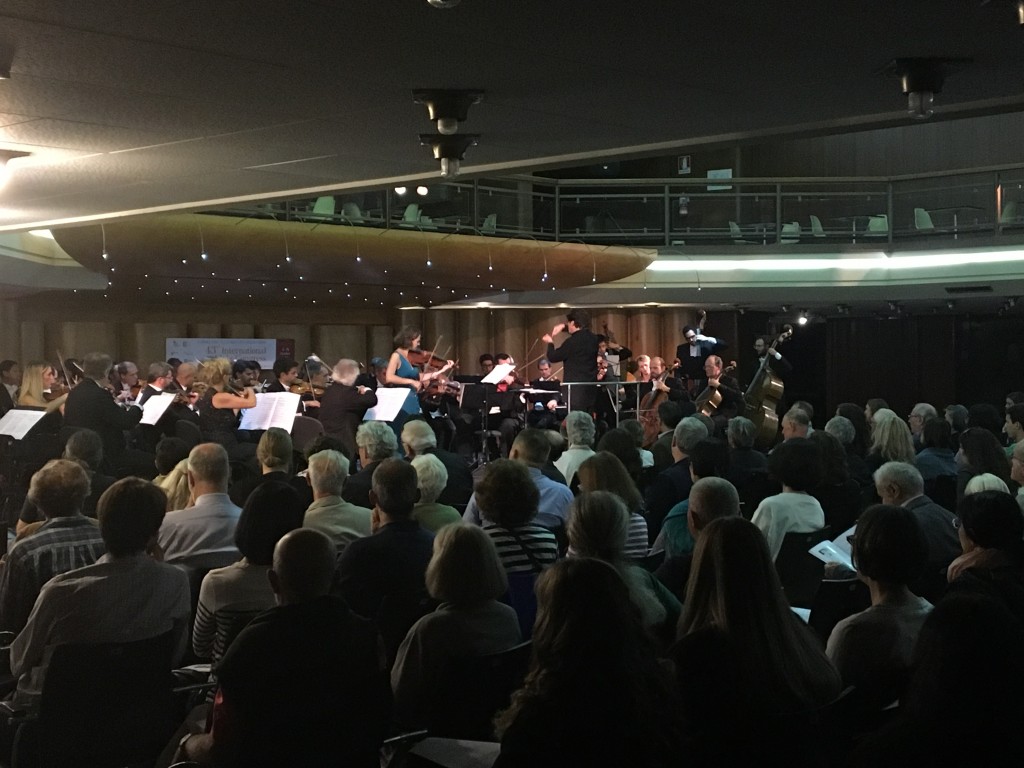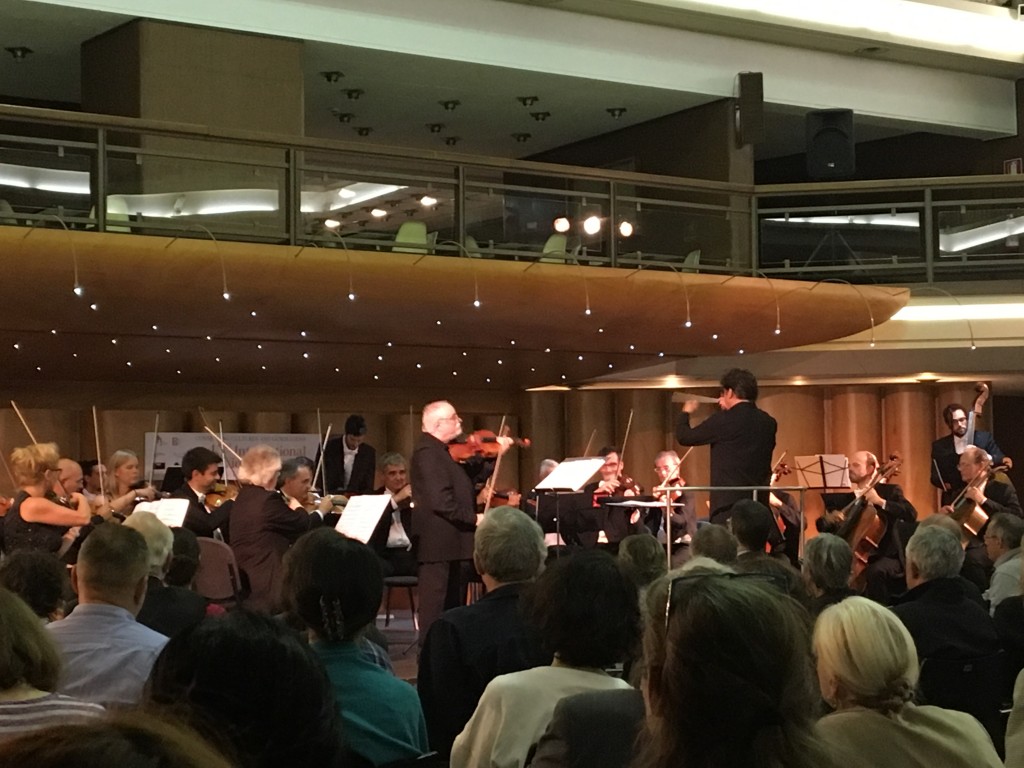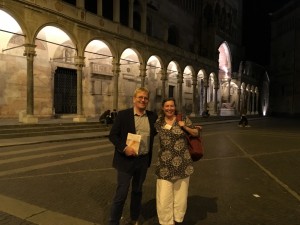De DVS is aanwezig bij het International Viola Congress 2016 in Cremona. Hier brengen DVS-bestuursleden Kristofer Skaug en Karin Dolman dagelijks verslag.
Jump to English Translation below.
Dinsdag 4 oktober 2016

We werden ontvangen bij de Camera di Commercio di Cremona (Kamer van koophandel), die op de hoek van de mooie Piazza Duomo (domplein) ligt. Dit is de hoofdlocatie van het congres, met drie mooie zalen voor concerten en lezingen, en een aantal foyers waar de vioolbouwers van de stad trots hun werk tonen.
Bij de receptie kregen we een goodie bag, maar dan zonder tas! Dus je moest een heleboel zaken opeens jongleren; naast het uitgebreide programmaboekje o.a. een dubbel-CD met

prachtige oude opnames van (met name) Italiaanse componisten en/of altviolisten; een gratis set Kaplan-snaren naar keuze, en een hele bos stickers, folders en flyers.
Geïnspireerd door het rijkgevulde programmaboekje liet ik me (ver)leiden tot een bezoekje aan hetTeatro Filodrammatico, alwaar een aan het congres verbonden

internationaal altvioolconcours in zijn voorlaatste ronde loopt. Ik mocht even binnensluipen, en maakte nog net het halve-finale-optreden van Muriël Razavi mee. Mooi gebrachte solosonates van Ligeti en Bach, plus het Konzertstück van Enescu!

Hierna was de officiële opening van het IVC 2016 aan de beurt. Na welkomstwoorden van onze gastvrouw Dorotea Vismara (voorzitter van het congres en van de AIV – de italiaanse Viola Society), kwamen aan het woord de burgemeester van Cremona, de voorzitter van Kamer van Koophandel en (bij verstek) een voorgelezen brief van de minister van Cultuur. Eregast en tevens nestor van de italiaanse altvioolwereld Bruno Giuranna sloot het rijtje af met een paar goedgeplaatste woorden.
Direct hierop volgde het openingsrecital van het congres, met als titel “Bel Canto and Viola”. We kregen voorgeschoteld opera-arias van o.a. Donizetti, Rossini, Mozart en Leoncavallo. Een beetje veel van hetzelfde, wel virtuoos gespeeld en met een mooie toon.
Afgevaardigde Dwight Pounds van de American Viola Society gaf een lezing over David Dalton en William Primrose, hierin waren een aantal zeldzame filmpjes van Primrose te zien, waaronder een uitgebreid interview. Er werd ook uitleg gegeven over de totstandkoming van de Primrose International Viola Archive (PIVA), een grote verzameling van historische altviool-gerelateerde foto’s, boeken, bladmuziek, films en opnames die zich nu bevindt bij de Brigham Young University in Utah. Dit riep bij mij onmiddellijk de vraag op, hoe deze cultuurschat in verbinding kan worden gebracht met altviolisten wereldwijd en de diverse initiatieven in andere landen om de altvioolcultuur en -geschiedenis te registreren. Wordt vervolgd!
Intussen was ook Karin (Dolman) aangekomen in Cremona, net op tijd voor de masterclass van Tabea Zimmermann. We zagen twee kandidaten, beiden uit Italië. Toch een beetje jammer dat de congresorganisatie niet meer heeft gedaan om buitenlandse studenten te lokken voor de masterclasses. De masterclass van Tabea was zeer inspirerend. Ze pakte feilloos de punten eruit waar aan gewerkt kon worden, zonder negatief te zijn, zelfs opbouwend. Met veel geduld werkte ze met de twee studenten.
 Vlak na de masterclass was de beurt aan Alfonso Ghedin met een discussie over intonatie en set-up van je instrument. Wat heeft dat met elkaar te maken? Volgens de aan het woord zijnde vioolbouwer uit Cremona krijg je onnodige intonatieproblemen wanneer je instrument niet goed is afgesteld. In de vreselijke gevallen die hij laat zien is dat dan ook heel aannemelijk. Toetsen waarvan de snaren 2 millimeter ingesleten waren; en een soort wasbordeffect van een violist die duidelijk alleen nog de hoge tweede vinger had leren spelen, te korte stapels waar een stukje aangeplakt was (lijkt nog meer werk dan een nieuwe stapel snijden, wat dat betreft wel petje af!).
Vlak na de masterclass was de beurt aan Alfonso Ghedin met een discussie over intonatie en set-up van je instrument. Wat heeft dat met elkaar te maken? Volgens de aan het woord zijnde vioolbouwer uit Cremona krijg je onnodige intonatieproblemen wanneer je instrument niet goed is afgesteld. In de vreselijke gevallen die hij laat zien is dat dan ook heel aannemelijk. Toetsen waarvan de snaren 2 millimeter ingesleten waren; en een soort wasbordeffect van een violist die duidelijk alleen nog de hoge tweede vinger had leren spelen, te korte stapels waar een stukje aangeplakt was (lijkt nog meer werk dan een nieuwe stapel snijden, wat dat betreft wel petje af!).
Vervolgens liet een studente drie voorbeelden horen van instrumenten die in wisselende mate goede intonatie uit zich zelf hebben. De demonstratie is echter niet echt overtuigend, want het meisje doet het eigenlijk heel goed op alle drie instrumenten.
Na het eten wachtte ons nog een spectaculair avondconcert, met orkest. De eerste artiest (in de hoedanigheid van jeugd-eregast van het Congres) was onze eigen Dana Zemtsov, die met orkest de Romanze van Bruch mocht spelen. En wat deed ze het goed! Mooie toon en een lust voor het oog. Ze speelde inspirerend, als een doorgewinterde soliste.
Daarna kregen we het celloconcert van Schumann, in een bewerking voor altviool. Ik wist nog niet dat die bestond. en benieuwd waren we natuurlijk. De uitvoering van Ettore Causa was charmant. Met grote virtuositeit en bravoure leidde hij ons door dit concert. Een groot applaus kreeg hij dan ook als dank.
 Maestro Michael Kugel mocht vervolgens zijn slag slaan met de door hemzelf bewerkte vioolvariaties “Carnavale di Venezia” van Paganini. De kenners beweerden dat hij alle 24 variaties heeft gespeeld, een ongewone prestatie! Kugel stond bijna onbewogen, vooral links, maar rechts liet hij zien waarom hij terecht maestro genoemd mag worden.
Maestro Michael Kugel mocht vervolgens zijn slag slaan met de door hemzelf bewerkte vioolvariaties “Carnavale di Venezia” van Paganini. De kenners beweerden dat hij alle 24 variaties heeft gespeeld, een ongewone prestatie! Kugel stond bijna onbewogen, vooral links, maar rechts liet hij zien waarom hij terecht maestro genoemd mag worden.
 Na een klein changement was de beurt aan Tabea Zimmermann, die de “Naturale” voor altviool, slagwerk en stem op tape van Luciano Berio vertolkte. Tot aan haar optreden zat ze nog gewoon in de zaal, ging even naar achteren om zich om te kleden en haar instrument te stemmen… en dan zo’n geweldige vertolking van dit werk! Het ziet er ook Naturale uit, en het klinkt Naturale. Het is moeilijk te vergelijken met de stukken met orkest, maar het leek wel alsof haar altviool 10 keer zo groot is als de rest. Heel Cremona kon meegenieten. En goed gekozen dit stuk met de italiaanse volkszangstem (of is het Sardijns?).
Na een klein changement was de beurt aan Tabea Zimmermann, die de “Naturale” voor altviool, slagwerk en stem op tape van Luciano Berio vertolkte. Tot aan haar optreden zat ze nog gewoon in de zaal, ging even naar achteren om zich om te kleden en haar instrument te stemmen… en dan zo’n geweldige vertolking van dit werk! Het ziet er ook Naturale uit, en het klinkt Naturale. Het is moeilijk te vergelijken met de stukken met orkest, maar het leek wel alsof haar altviool 10 keer zo groot is als de rest. Heel Cremona kon meegenieten. En goed gekozen dit stuk met de italiaanse volkszangstem (of is het Sardijns?).

Your intrepid reporters in Cremona!
Verwachte highlights morgen: Recital Tabea Zimmermann met haar studenten, recital Jutta Puchhammer (die de reiskosten voor onze studenten heeft gesponsord), en natuurlijk het eerste straatconcert van juist die studenten: Ursula, Kardelen, Oksana en Raquel!
Kristofer Skaug en Karin Dolman
Tuesday, October 4th 2016
We were received at the Chamber of Commerce, at a corner of the beautiful Piazza Duomo. This is the principal location of the IVC 2016, housing three nice auditoriums for concerts and lectures, and extra foyer space for luthiers’ exhibitions.
We were given a goodie bag, but without the bag! So you suddenly had to juggle a lot of stuff, next to the extensive congress programme booklet we also received a double CD with beautiful old recordings of (mostly) Italian composers and violists; a free set of Kaplan strings, and a whole bunch of promotional stickers, folders and flyers.
Inspired by the richly populated programme guide, I decided to visit the nearby Teatro Filodrammatico, where the International Viola Competition (liaised to the Congress) was unfolding in its semifinal round. I was allowed to sneak in, just in time for the performance of Muriël Razavi. She brought very good renditions of the Ligeti solo sonata, a Bach partita and the Enescu Concert Piece.
Next up was the official Opening Ceremony of the IVC 2016. After welcoming words from our hostess Dorotea Vismara (also president of the Italian Viola Society AIV), we had speeches by the Mayor of Cremona, the President of the Chamber of Commerce, and a letter from the minister of Culture. The ceremony was concluded with some well put remarks by honorary guest mr. Bruno Giuranna.
The Ceremony was followed by the first recital of the congress, with the title “Bel Canto and Viola”. We were treated to operatic arias by Donizetti, Rossini, Mozart and Leoncavallo. To our taste this programme offered too little variety, but it was played with appropriate virtuosity and a pleasant tone.
Next, the American delegate Dwitght Pounds gave a lecture about David Dalton and William Primrose; a number of rare films of Primrose were shown, including an extensive interview. Mr. Pounds also described the establishment of the Primrose International Viola Archive (PIVA), a large collection of historical viola-related pictures, books, sheet music, films and recordings, which is currently housed at the Brigham Young University in Utah. It made me wonder how this cultural treasure could be made more accessible to violists around the world, and how it could be connected to the efforts in other countries to record local viola culture and history. To be continued!
In the meantime, also Karin (Dolman, DVS President) has arrived in Cremona – just in time for the Masterclass by Tabea Zimmermann. We were presented with two students, both from Italy. We note that these masterclass opportunities were not particularly well advertised to the participating students from abroad. The teaching of Tabea Zimmermann is very inspiring. She always spots the issues that the student needs to work on, but without too much negativity, instead patiently and encouraging.
After the masterclass, mr. Alfonso Ghedin leads a discussion/workshop investigating the relationship between intonation and instrument set-up: fingerboard profile, string height, bridge profile, sound post placement and tailpiece length. And so what is this relationship? According to the co-presenting luthier from Cremona, sub-optimal setup invariably leads to unnecessary intonation challenges/problems. In the quite awful examples shown (photographs), this sounds very plausible. Fingerboards in which two millimetre gouges have been worn-in by the strings. A washboard effect caused by a violist who clearly never learned to find the “low 2nd finger” position; too-short sound posts which had been elongated by gluing-on an extension segment.
Next a student demonstrates the effects of bad and good set-up by playing three different violas. This demonstration is however not very convincing, because the girl clearly manages quite well on all three instruments.
After dinner, the official Opening Concert awaited us, with orchestra!
The first artist of the evening was “our own” Dana Zemtsov. She played the Bruch Romanze admirably well. A beautiful tone, and a pleasant countenance. Her playing was very inspiring, and she exhibited a lot of maturity and experience on stage.
Next up was a Schumann cello concerto, transcribed for the viola. Who knew it existed?
Mr. Ettore Causa’s performance was very charming, with great virtuosity and bravura. The extensive applause was well-deserved.
After this it was Maestro Michael Kugel’s turn to present his own viola elaborations on Paganini’s violin variations “Carnavale di Venezia”. The conoisseurs reported that he had played all 24 variations, an unusual feat! Kugel stood unperturbed in all the virtuosics, especially with his left hand. But his right arm clearly showed by we may call him a true Maestro.
After a short intermission, Tabea Zimmermann took the stage with the “Naturale” for viola, percussion and recorded voice by Luciano Berio. What an interpretation it was! It even looks and sounds Naturale, what she does. It is of course difficult to compare the sound levels directly with the orchestra pieces earlier on, but her viola sounded ten times bigger than any other instrument. The Berio piece was a good choice in itself, with the Italian folksong voice (or was it Sardinian?).
Some of the highlights expected tomorrow: Recitals of Tabea Zimmermann with her students, as well as a recital with Jutta Puchhammer (who kindly subsidized our students’ travel costs). And of course the first (out of two) street concert performance(s) of “our” students: Ursula, Kardelen, Oksana and Raquel!
Kristofer Skaug and Karin Dolman
